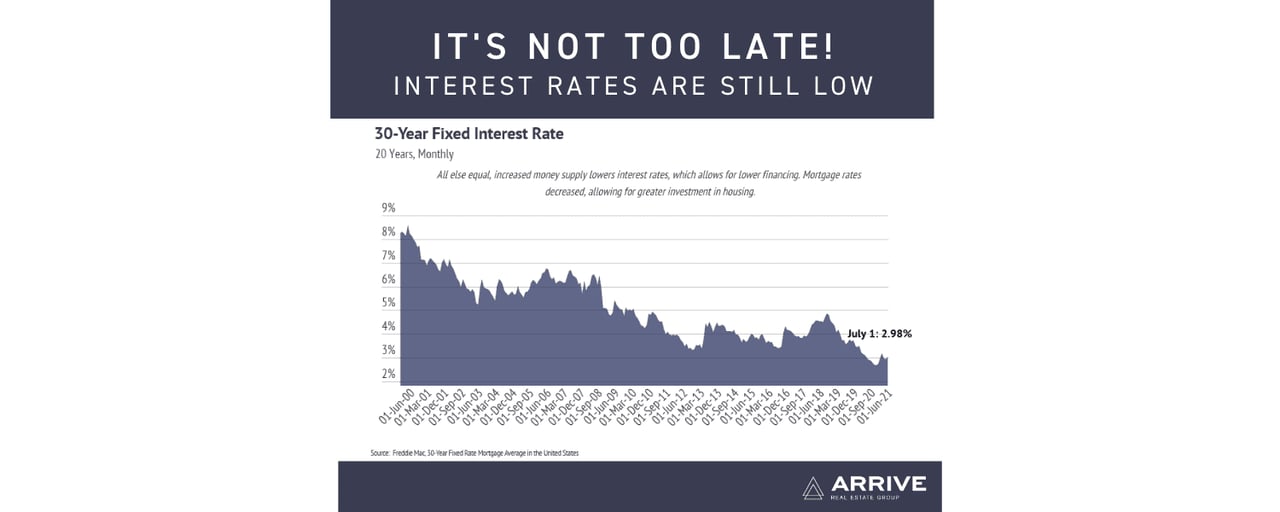Welcome to our July newsletter, where we’ll explore residential real estate trends in the East Bay and across the nation. We will examine how buyer demand might shift during the rest of the year. Focusing on the historically low inventory, record high prices, and the Federal Reserve Bank’s incentives to keep interest rates low despite rising inflation.
Key Topics and Trends
We’ve entered into an economic situation that is uncommon, at least in recent history, with rising inflation and high unemployment. The Federal Reserve Bank (the Fed) has two goals known as the dual mandate: price stability (inflation) and maximum sustainable employment. The pandemic threw a sizable wrench in the economic machine, causing mass unemployment from which we are still recovering.
Easy monetary policy brought more money into circulation, a drop in interest rates and caused a swift rise in inflation, about 5%. After a decade of relatively low inflation, often under 2% annually, consumers are noticing the price jumps. The price increases are partly due to monetary policy and partly due to global supply chain disruptions caused by the pandemic. As the pandemic fades on a more global basis and supply chains stabilize, prices should correct, at least to an extent. For the moment, the Fed has decided to keep interest rates low and continue infusing money into the economy.
Even though inflation has become more noticeable, the Fed still must consider the employment rate. Employment hasn’t reached pre-pandemic levels, and the growth rate has slowed. Because employment typically grows at such a constant rate, we still have around 10.5 million fewer employed people than if there had never been a pandemic.
A sharp drop in home prices would wipe out significant wealth and put many new homeowners underwater. These are huge disincentives to change the current path to prevent a market crash. We’re currently hovering at historically low mortgage rates, which will likely remain for the rest of the year as they incentivize buying, as does inflation. When consumers know the dollar’s purchasing power is diminishing more quickly, then buying a home sooner rather than later makes more sense.
July Housing Market Updates for the East Bay
Single-family home inventory began to climb at the start of 2021, but declined in May, as sales remained high. In 2020, fewer people wanted to leave the East Bay, while more people wanted to move to the area. This trend caused an increase in population, which drove inventory down to record low levels. New listings, therefore, improve the current market conditions. In May 2021, the East Bay had nearly 16% fewer homes for sale than it did in May 2020. While the sustained low inventory may cause prices to appreciate throughout 2021, we are also starting to experience a shift in the market.
Locally, we have noticed a decline in the number of offers being submitted. It is too early to say if this is part of a larger trend or merely buyers busy enjoying the last weeks of summer vacation. If you have been trying to buy a home this year but haven’t been able to compete, now may be your chance. There is still time to capitalize on low interest rates and possibly, lower prices than we have experienced earlier in the year.
In Summary
Overall, the housing market has shown its value through the pandemic and remains one of the most valuable asset classes. The data show that housing has remained consistently strong throughout this period.
As always,
Arrive Real Estate Group remains committed to helping our clients achieve their current and future real estate goals. Our team of experienced professionals are happy to discuss the information we have shared in this newsletter. We welcome you to
contact us with any questions about the current market or to request an evaluation of your home.

